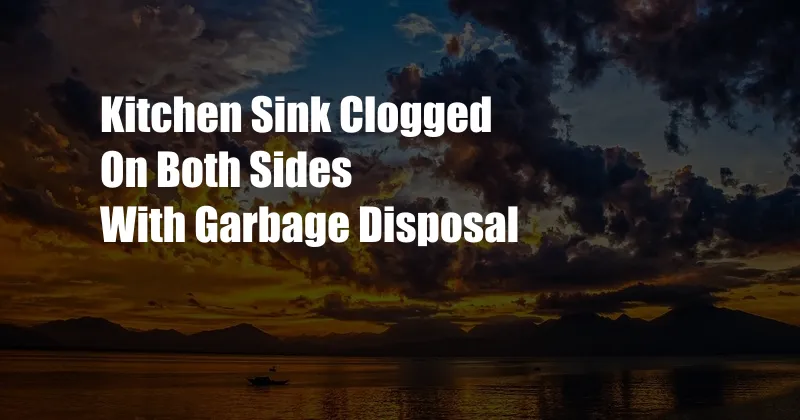
Kitchen Sink Clogged on Both Sides With Garbage Disposal: A Comprehensive Guide
A clogged kitchen sink, particularly one that’s obstructed on both sides with a garbage disposal, can be a frustrating and daunting problem. I once experienced this myself, leaving me with a pile of dirty dishes and a sink full of stagnant water. Determined to resolve the issue, I embarked on a journey to understand the causes and solutions related to this plumbing predicament.
If you find yourself in a similar situation, fear not! This comprehensive guide will provide you with an in-depth understanding of clogged kitchen sinks with garbage disposals. We’ll explore the reasons behind the blockage, delve into effective troubleshooting methods, and equip you with expert tips to prevent future occurrences.
Diagnosing the Clog: Uncovering the Culprits
Kitchen sink clogs can stem from various sources. Food debris, grease, and other particles can accumulate within the disposal unit or the drainpipe, restricting water flow. The garbage disposal itself can malfunction due to jammed blades, electrical issues, or overload. Additionally, the P-trap, a curved section of pipe beneath the sink, can collect debris and contribute to the blockage.
To identify the precise location of the clog, try running water through the disposal. If water backs up into the sink, the issue is likely within the disposal unit or the P-trap. Alternatively, if water drains slowly from both sides of the sink, the clog may be further down the drainpipe.
Clearing the Clog: A Step-by-Step Guide
Once you’ve pinpointed the source of the clog, it’s time to tackle the blockage. Here’s a step-by-step guide to help you clear the clog:
- Reset the garbage disposal: If the disposal has tripped its circuit breaker, reset it by pressing the small red button located on the bottom of the unit.
- Use a drain snake: Insert the drain snake into the disposal or drainpipe and crank it to break up the clog. Be sure to wear gloves and follow the manufacturer’s instructions for safe operation.
- Disassemble the P-trap: Place a bucket beneath the P-trap to catch any water or debris. Unscrew the slip nuts that connect the P-trap to the sink and drainpipe. Clean out any accumulated gunk and reassemble the trap.
- Call a plumber: If home remedies fail to resolve the clog, it’s advisable to seek professional assistance. A plumber can use specialized tools and techniques to clear stubborn blockages and ensure proper drainage.
Expert Advice for Preventing Future Clogged Sinks
To minimize the likelihood of future kitchen sink clogs, consider implementing these expert tips:
- Dispose of food waste properly: Avoid putting large amounts of food scraps, grease, and fibrous materials down the disposal. Instead, compost or discard them in the trash.
- Regularly clean the garbage disposal: Run a mixture of ice cubes and baking soda through the disposal to grind and scour the blades. This helps prevent food buildup and odors.
- Use drain covers: Install drain covers in both the kitchen sink and garbage disposal to catch debris before it enters the排水系统.
- Periodically flush the drains: Pour a pot of boiling water down the drains to dissolve grease and prevent buildup.
FAQ: Answering Your Burning Questions
Q: Why is my kitchen sink clogged on both sides with the garbage disposal?
A: The clog may be located in the disposal unit, P-trap, or drainpipe. Food debris, grease, and other particles can accumulate and restrict water flow.
Q: How can I prevent kitchen sink clogs?
A: Dispose of food waste properly, clean the garbage disposal regularly, use drain covers, and periodically flush the drains with hot water.
Q: When should I call a plumber for a clogged kitchen sink?
A: If home remedies fail to resolve the clog or if the clog is severe, it’s advisable to seek professional assistance from a plumber.
Conclusion
A clogged kitchen sink with a garbage disposal can be a frustrating inconvenience, but understanding the causes and solutions can empower you to tackle the problem effectively. By following the troubleshooting tips and expert advice outlined in this guide, you can clear the clog and prevent future occurrences. If you encounter a particularly stubborn clog or suspect a more complex issue, don’t hesitate to reach out to a qualified plumber for professional assistance.
Are you interested in learning more about kitchen sink clogs or other plumbing-related topics? Let us know in the comments section below. Your feedback helps us create more informative and engaging content for our readers.